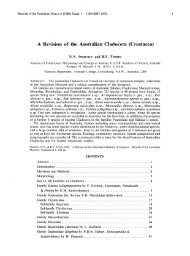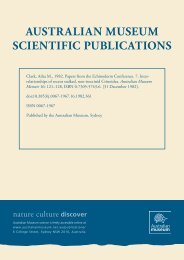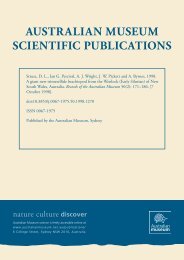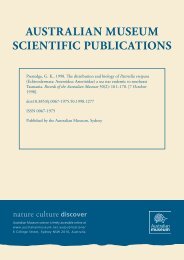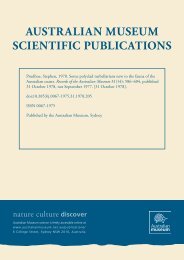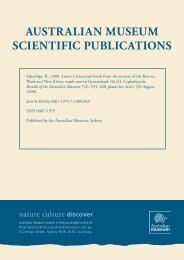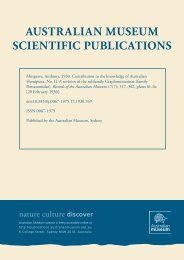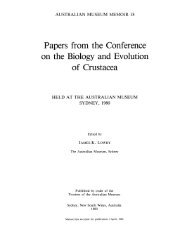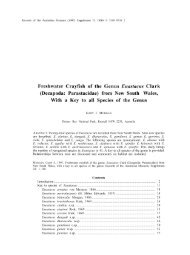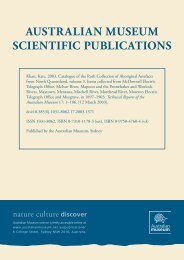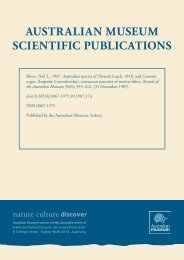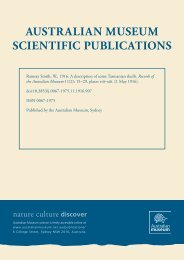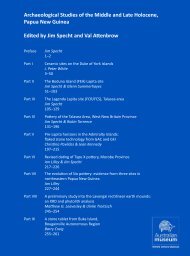Revision of the genera Sphodropoda, Trachymantis and ...
Revision of the genera Sphodropoda, Trachymantis and ...
Revision of the genera Sphodropoda, Trachymantis and ...
You also want an ePaper? Increase the reach of your titles
YUMPU automatically turns print PDFs into web optimized ePapers that Google loves.
© Copyright Australian Museum, 2005<br />
Records <strong>of</strong> <strong>the</strong> Australian Museum (2005) Vol. 57: 191–210. ISSN 0067-1975<br />
<strong>Revision</strong> <strong>of</strong> <strong>the</strong> Genera<br />
<strong>Sphodropoda</strong>, <strong>Trachymantis</strong> <strong>and</strong> Zopheromantis<br />
(Mantodea: Mantidae: Mantinae)<br />
G.A. MILLEDGE<br />
Terrestrial Zoology, Australian Museum,<br />
6 College Street, Sydney NSW 2010, Australia<br />
grahamm@austmus.gov.au<br />
ABSTRACT. The <strong>genera</strong> <strong>Sphodropoda</strong> Stål, <strong>Trachymantis</strong> Giglio-Tos <strong>and</strong> Zopheromantis Tindale are<br />
revised. Aspects <strong>of</strong> <strong>the</strong>ir biology are discussed <strong>and</strong> distributions given. One new species <strong>of</strong> <strong>Sphodropoda</strong>,<br />
S. lepida, is described. <strong>Sphodropoda</strong> moesta Giglio-Tos, S. mjobergi Sjöstedt <strong>and</strong> S. papua are new<br />
synonyms <strong>of</strong> S. tristis (Saussure). <strong>Sphodropoda</strong> dentifrons Stål is transferred to <strong>Trachymantis</strong>. S. loripes<br />
Tindale is transferred to Zopheromantis. Z. trimaculata Tindale is a new synonym <strong>of</strong> Z. loripes.<br />
MILLEDGE, G.A., 2005. <strong>Revision</strong> <strong>of</strong> <strong>the</strong> <strong>genera</strong> <strong>Sphodropoda</strong>, <strong>Trachymantis</strong> <strong>and</strong> Zopheromantis (Mantodea:<br />
Mantidae: Mantinae). Records <strong>of</strong> <strong>the</strong> Australian Museum 57(2): 191–210.<br />
<strong>Sphodropoda</strong> Stål, <strong>Trachymantis</strong> Giglio-Tos <strong>and</strong> Zopheromantis<br />
Tindale are three closely related mantid <strong>genera</strong>,<br />
known only from mainl<strong>and</strong> Australia <strong>and</strong>, in <strong>the</strong> case <strong>of</strong><br />
<strong>Sphodropoda</strong>, Papua New Guinea, <strong>the</strong> Solomon Isl<strong>and</strong>s <strong>and</strong><br />
possibly Fiji. All are shrub <strong>and</strong> tree dwellers, <strong>and</strong> most <strong>of</strong><br />
<strong>the</strong> species inhabit drier regions.<br />
Stål (1871) erected <strong>Sphodropoda</strong> as a subgenus <strong>of</strong><br />
Hierodula Burmeister <strong>and</strong> included a single species, H.<br />
(<strong>Sphodropoda</strong>) tristis (Saussure). Westwood (1889) elevated<br />
<strong>Sphodropoda</strong> to generic level. <strong>Trachymantis</strong> was erected<br />
by Giglio-Tos (1917) for T. obesa Giglio-Tos <strong>and</strong><br />
Zopheromantis by Tindale (1924) for Z. trimaculata Tindale.<br />
Beier (1935) incorrectly synonymized Zopheromantis with<br />
Hierodula without giving reasons. Zopheromantis is<br />
recognized here as a valid genus.<br />
Materials <strong>and</strong> methods<br />
Methods <strong>and</strong> terminology follow Milledge (1990, 1997).<br />
The following abbreviations are used for male genitalia:<br />
apr, apical process <strong>of</strong> left phallomere; dpr, distal process<br />
<strong>of</strong> ventral phallomere; pa, phalloid apophysis. Measure-<br />
ments are in mm <strong>and</strong> range from <strong>the</strong> smallest specimen<br />
examined to <strong>the</strong> largest, except where an insufficient range<br />
<strong>of</strong> material was available, when single measurements are<br />
given. Abbreviations used for institutions where material is<br />
held are as follows: AM, Australian Museum, Sydney;<br />
ANIC, Australian National Insect Collection, Canberra;<br />
BMNH, The Natural History Museum, London; NHRM,<br />
Swedish Museum <strong>of</strong> Natural History, Stockholm; NMV,<br />
Museum Victoria, Melbourne; SAM, South Australian<br />
Museum, Adelaide; WAM, Western Australian Museum,<br />
Perth; ZMHU, Zoologisches Museum der Humbolt-<br />
Universitat, Berlin.<br />
Relationships<br />
These three <strong>genera</strong> appear to form a closely related group,<br />
sharing a number <strong>of</strong> characters including well-developed<br />
preacetabular spine, facial shield as wide as high, denticules<br />
between teeth on outer margins <strong>of</strong> fore femora <strong>and</strong> bifurcate<br />
distal process in <strong>the</strong> male genitalia. Beier (1964) placed<br />
<strong>Sphodropoda</strong> <strong>and</strong> <strong>Trachymantis</strong> in his Miomantini, a tribe<br />
www.amonline.net.au/pdf/publications/1442_complete.pdf
192 Records <strong>of</strong> <strong>the</strong> Australian Museum (2005) Vol. 57<br />
Figs. 1–6. Right fore femur, females, arrows indicate denticles. (1) Iris sp., ventral view; (2) same, ventral view, distal two thirds; (3)<br />
same retrolateral view, distal two thirds. (4) <strong>Sphodropoda</strong> quinquedens, ventral view; (5) same, ventral view, distal two thirds; (6) same<br />
retrolateral view, distal two thirds. Scales = 2 mm<br />
sharing only <strong>the</strong> single synapomorphy <strong>of</strong> denticules between<br />
<strong>the</strong> outer spines <strong>of</strong> <strong>the</strong> fore femora. He obviously had not<br />
examined specimens <strong>of</strong> Zopheromantis as he considered it<br />
to be a synonym <strong>of</strong> Hierodula (Mantini), which lacks this<br />
feature. There is some doubt as to whe<strong>the</strong>r <strong>the</strong> Miomantini<br />
is monophyletic, as <strong>the</strong> <strong>genera</strong> within it display a wide<br />
variety <strong>of</strong> forms. The denticules between <strong>the</strong> outer spines<br />
in <strong>the</strong> three <strong>genera</strong> considered here are really only small<br />
tubercules, <strong>and</strong> could be interpreted as a manifestation <strong>of</strong> <strong>the</strong><br />
relatively tuberculate cuticle <strong>the</strong>y possess. I have examined<br />
specimens <strong>of</strong> <strong>the</strong> European genus Iris Saussure, which Beier<br />
also included in his Miomantini. The pattern <strong>of</strong> denticles (Figs.<br />
1–3) is different from that found in <strong>the</strong> <strong>genera</strong> considered here<br />
(Figs. 4–6). In fact, <strong>the</strong> denticles are not between <strong>the</strong> outer<br />
spines but on <strong>the</strong> ventral surface <strong>of</strong> <strong>the</strong> femur. The original<br />
authors (Stål, Giglio-Tos <strong>and</strong> Tindale) considered <strong>the</strong> <strong>genera</strong><br />
revised here to be related to Hierodula. Although this seems<br />
more likely than Beier’s grouping, as noted elsewhere<br />
(Milledge, 1997), fur<strong>the</strong>r work is required on <strong>the</strong> mantid<br />
fauna <strong>of</strong> o<strong>the</strong>r parts <strong>of</strong> <strong>the</strong> world before <strong>the</strong> relationships <strong>of</strong><br />
<strong>the</strong> Australian fauna can be fully understood.<br />
<strong>Sphodropoda</strong> Stål<br />
<strong>Sphodropoda</strong> Stål, 1871: 399. Type species <strong>Sphodropoda</strong> tristis<br />
Saussure, by original designation.<br />
Diagnosis. Head about as high as wide, frontal shield<br />
without dorsal extensions; preacetabular spine strong; inner<br />
face <strong>of</strong> first tarsal segment partly or wholly black, ventral<br />
face <strong>of</strong> fore femur tuberculate, especially toward outer<br />
margin; both sexes macropterous (some females slightly<br />
brachypterous), ventral face <strong>of</strong> costal area <strong>of</strong> tegmen at least
partly red. Can be distinguished from <strong>Trachymantis</strong> by <strong>the</strong><br />
lack <strong>of</strong> a tooth on <strong>the</strong> apex <strong>of</strong> <strong>the</strong> frontal shield <strong>and</strong> from<br />
Zopheromantis by <strong>the</strong> hind femur being only about half <strong>the</strong><br />
length <strong>of</strong> <strong>the</strong> abdomen.<br />
Description. Small to moderately large, body robust, male<br />
macropterous, female macropterous to slightly brachypterous.<br />
Head about as wide as high, not significantly<br />
compressed anteroposteriorly, apical margin gently arched;<br />
eyes rounded, not particularly prominent; frontal shield<br />
slightly wider than high, flat, with distinct ridge laterally<br />
<strong>and</strong> apically but not produced into a tooth at apex.<br />
Pronotum moderately elongate, supracoxal expansion<br />
slight to distinct, dorsal surface finely to moderately coarsely<br />
granulate, margins finely denticulate, ventral surface with<br />
preacetabular spine prominent. Fore coxa as long as or<br />
longer than metazone <strong>of</strong> pronotum, <strong>of</strong>ten with distinctive<br />
pattern on inner face <strong>and</strong> a number <strong>of</strong> prominent tubercles<br />
on anterior margin. Fore femur finely tuberculate on ventral<br />
surface, particularly toward outer margin; with four<br />
discoidal spines, relative length from longest to shortest 3-<br />
2-1-4; with four outer <strong>and</strong> 15 inner spines, claw groove<br />
Key to species <strong>of</strong> <strong>Sphodropoda</strong><br />
Milledge: revision <strong>of</strong> three mantid <strong>genera</strong> 193<br />
situated at about a third <strong>the</strong> total distance from base. Inner<br />
face <strong>of</strong> tarsus largely black.<br />
Tegmen with costal area opaque, partially red beneath;<br />
discoidal area entirely opaque to mostly hyaline. Hind wing<br />
with costal <strong>and</strong> discoidal area pigmented, anal area largely<br />
hyaline. Mid <strong>and</strong> hind legs relatively short, hind femur about<br />
half <strong>the</strong> length <strong>of</strong> abdomen. Abdomen moderately elongate,<br />
cerci short, slender <strong>and</strong> cylindrical. Male genitalia with dpr<br />
bifurcate.<br />
Notes. All <strong>the</strong> species in this genus have relatively short<br />
legs, a feature that appears to be associated with <strong>the</strong><br />
behavioural adaptation <strong>of</strong> depressing <strong>the</strong> body against <strong>the</strong><br />
substrate when threatened. This behaviour has been<br />
observed in three <strong>of</strong> <strong>the</strong> species recognized here (S. tristis,<br />
S. quinquedens <strong>and</strong> S. viridis), <strong>the</strong> behaviour <strong>of</strong> <strong>the</strong> o<strong>the</strong>r<br />
(S. lepida) has not been observed. If <strong>the</strong> substrate is a branch<br />
or twig this behaviour includes moving to <strong>the</strong> side <strong>of</strong> <strong>the</strong><br />
branch facing away from <strong>the</strong> threat. Similar behaviour<br />
appears to have evolved independently in o<strong>the</strong>r <strong>genera</strong> <strong>of</strong><br />
Mantidae, e.g., Tarachodula (Preston-Mafham 1990, plate<br />
33) <strong>and</strong> Galepsus (Hevers & Liske 1991, plate 21).<br />
1 Internal face <strong>of</strong> fore coxa with 5–6 transverse white b<strong>and</strong>s<br />
anteriorly (Fig. 15) .................................................................................................. S. quinquedens<br />
—— Internal face <strong>of</strong> fore coxa lacking b<strong>and</strong>s ....................................................................................... 2<br />
2 Anterior margin <strong>of</strong> fore coxa internally with six to seven whitish<br />
tubercles (Fig. 12) .............................................................................................................. S. tristis<br />
—— Anterior margin <strong>of</strong> fore coxa without such tubercles .................................................................... 3<br />
3 Major veins <strong>of</strong> discoidal area <strong>of</strong> tegmina uniformly green .............................................. S. viridis<br />
—— Major veins <strong>of</strong> discoidal area <strong>of</strong> tegmina flushed reddish brown .................................... S. lepida<br />
<strong>Sphodropoda</strong> tristis (Saussure)<br />
Figs. 7–8, 11–13, 17, 42<br />
Mantis tristis Saussure, 1871: 93.<br />
Hierodula (<strong>Sphodropoda</strong>) tristis (Saussure).–Stål, 1871: 399.<br />
<strong>Sphodropoda</strong> tristis (Saussure).–Westwood, 1889: 13.<br />
<strong>Sphodropoda</strong> moesta Giglio-Tos, 1911: 20; new synonym.<br />
<strong>Sphodropoda</strong> mjobergi Sjöstedt, 1918: 25; new synonym.<br />
<strong>Sphodropoda</strong> papua Beier, 1965: 489–90; new synonym.<br />
Type material examined. Syntype female <strong>of</strong> <strong>Sphodropoda</strong><br />
moesta, Cape York, Daemel, cat. no. 3883 (ZMHU). Syntype<br />
male <strong>and</strong> syntype female <strong>of</strong> <strong>Sphodropoda</strong> mjobergi,<br />
Kimberley district, N.W. Australia, Mjöberg (NHRM).<br />
O<strong>the</strong>r specimens examined. Queensl<strong>and</strong>. 1�, Armstrong Creek<br />
crossing, 13 km NNW <strong>of</strong> Guthalungra, 26 Jan 1982, M.S. & B.J. Moulds.<br />
1�, Biggenden Bluff, Mt. Walsh National Park, 10 Jan 1984, D. Rugg.<br />
1�, 1�, 7 km S <strong>of</strong> Biggenden, Mt. Walsh National Park, 9–12 Apr<br />
1971, H. Frauca. 5�, Bluff Range, near Biggenden, 2–12 May 1971, H.<br />
Frauca. 2 juv, Bluff Range, 8 km S <strong>of</strong> Biggenden, 9 Jan 1971, H. Frauca.<br />
1�, 20 km NE <strong>of</strong> Bundaberg, Apr 1971, H. Frauca. 1�, Byfield, 10<br />
May 1955, Common & Norris. 2�, 1�, Carnarvon National Park (Tourist<br />
Lodge), 25°05'S 148°15'E, 27 & 29 Apr 1979, K.H.L. Key. 1�, Clermont,<br />
15 Feb 1975, R.A. Farrow. 3�, 7 km SSW <strong>of</strong> Clermont, 2 Apr 1977,<br />
R.C. Lewis. 1�, 1 juv, near Clohesy River 12 km SW <strong>of</strong> Kur<strong>and</strong>a, 7 Feb<br />
1988, 16°54'S 145°34'E, D.C.F. Rentz. 1 juv, 52 km SE <strong>of</strong> Cloncurry,<br />
25 Aug 1960, M.J.D. White. 1 juv, Desailly Creek, 10 km NW <strong>of</strong> Mt.<br />
Carbine, 16°30'S 144°55'E, 19–21 May 1981, D.C.F. Rentz. 1�, 1 juv,<br />
8 km W <strong>of</strong> Dimbulah, 17°09'S 145°02'E, 22 Mar 1988, D.C.F. Rentz.<br />
1�, 42 km N <strong>of</strong> Emerald, 20 Apr 1955, Norris & Common. 1�, Forty<br />
Mile Scrub, 55 km SSW <strong>of</strong> Mt. Garnet, 18°06'S 144°50'E, 8 Dec 1985,<br />
J. Balderson. 1�, 3 km N <strong>of</strong> Greenvale HS, W <strong>of</strong> Ingham, 5 Apr 1962,<br />
K.H.L. Key & E.L. Corby. 1 juv, Isla Gorge Lookout, Isla Gorge National<br />
Park, SSW <strong>of</strong> Theodore, 25°10'S 150°00'E, 21 Apr 1982, D.C.F. Rentz.<br />
1�, 3 km SE <strong>of</strong> Mary Kathleen, 21 Apr 1962, K.H.L. Key & E.L. Corby.<br />
1�, Moondoo, 26 Feb 1963, A.L. Dyce & M.D. Murray. 1 juv, 10 km<br />
SE <strong>of</strong> Mt. Carbine, 16°37'S 145°12'E, 24 Nov 1981, J. Balderson. 1 juv,<br />
17 km WSW <strong>of</strong> Mt. Faulkner, Clermont district, 7 Jan 1965, M.J.D.<br />
White. 1�, Mt. Larcom, 18 Apr 1955, Norris & Common. 2�, Running<br />
River, 22 km W <strong>of</strong> Paluma, 11 Feb 1971, J.G. Brooks. 1�, near Poona<br />
Lake, Cooloola National Park, 25°58'S 153°07'E, 4 Apr 1978, D.C.F &<br />
B.G.F. Rentz. 1�, 1 km N <strong>of</strong> Rounded Hill, near Cooktown, 15°17'S<br />
145°13'E, 5–7 May 1981, D.C.F. Rentz. 1�, 23 km NNE <strong>of</strong> Taroom, 29<br />
Mar 1977, R.C. Lewis. 1�, 9 km WNW <strong>of</strong> Taroom, 25°34'S 149°45'E,<br />
1 Feb 1981, D.C.F. Rentz & D.T. Gwynne. 1 juv, 7 km E <strong>of</strong> Toowoomba,<br />
2 Jan 1956, M.J.D. White. 1�, Townsville, 7 Jan 1968, P. Ferrar. 1�,<br />
Townsville, 31 Dec 1967, P. Ferrar. 1�, Watalgan Range, near<br />
Bundaberg, 3 Jul 1971, H. Frauca. 1�, Watalgan Range, S <strong>of</strong> Rosedale,<br />
Mar 1971, H. Frauca. 1�, Waverley Creek, Bruce Highway, 10 km S <strong>of</strong><br />
St. Lawrence turn<strong>of</strong>f, 27 Jan 1988, M.S. & B.J. Moulds (All ANIC).<br />
1�, Auga<strong>the</strong>lla, 25°48'S 146°35'E, 18 Jan 1993, G. Milledge. 1�, 16<br />
km ESE <strong>of</strong> Burke & Wills Junction, 19°17'S 140°29'E, 15 Jan 1993, G.<br />
Milledge. 1�, 2� 1 km NNE <strong>of</strong> Collins Weir, W <strong>of</strong> A<strong>the</strong>rton, 17°15'S<br />
145°17'E, 10 Feb 1989, G. Milledge. 1�, 8 km E <strong>of</strong> Emuford, 30 Dec<br />
1989, M.S. & B.J. Moulds. 5�, Georgetown, 12–14 Apr 1991, G.<br />
Milledge. 1�, Georgetown, 16 Apr 1991, G. Milledge. 1�, 12 km E <strong>of</strong><br />
Georgetown, 12 Apr 1991, G. Milledge. 1�, 6 km S <strong>of</strong> Normanton,
194 Records <strong>of</strong> <strong>the</strong> Australian Museum (2005) Vol. 57<br />
Figs. 7–8. <strong>Sphodropoda</strong> tristis. (7) Male, dorsal; (8) female dorsal. Scale = 10 mm.<br />
17°44'S 141°05'E, 10 Jan 1993, G. Milledge. 1�, Oaky Creek Rd, 8 km<br />
W <strong>of</strong> Cooktown, 15°29'S 145°10'E, 8 Apr 1991, G. Milledge. 1�,<br />
Portl<strong>and</strong> Roads, Iron Range, 29 Oct 1991, J. Hasenpusch. 1�, 0.5 km S<br />
<strong>of</strong> Wills Creek, 9.5 km NE <strong>of</strong> Normanton, 17°38'S 141°09'E, 11 Jan<br />
1993, G. Milledge (all NMV).<br />
New South Wales. 1 juv, 29 km ENE <strong>of</strong> Coonabarabran, 31°08'S<br />
149°33'E, 25 Nov 1983, D.C.F. Rentz & M.S. Harvey. 1�, Dungay Creek,<br />
13 km W <strong>of</strong> Kempsey, I.H. Parberry. 1 juv, 5 km SE <strong>of</strong> Merrygoen, 18<br />
Jan 1961, M.J. D.White. 1�, 15 km WNW <strong>of</strong> Monia Gap, 2 Feb 1964,<br />
M.J.D. White. 1 juv, 10 km W <strong>of</strong> Temora, 12 Jan 1955, M.J.D. White<br />
(all ANIC). 1�, Clarence River, Mr Wilcox (NMV).<br />
Nor<strong>the</strong>rn Territory. 1�, 43 km SE <strong>of</strong> Adelaide River, 4 Nov 1966, A. & R.<br />
Mesa. 2�, Barrow Creek Telegraph Station, 20 Mar 1955, K.H.L. Key. 1<br />
juv, Berrimah, 10 Mar 1972, J.C. Wombey. 1�, 38 km ENE <strong>of</strong> Birrindudu<br />
HS, 18°15'S 129°45'E, 11 Jul 1969, C. Simpson. 1 juv, Blackfellows Station<br />
to Burnside, 2–3 Apr 1929, T.G. Campbell. 1�, Borroloola, McArthur River,<br />
16 Jun 1929, T.G. Campbell. 1�, 22 km WSW <strong>of</strong> Borroloola, 16°08'S<br />
136°06E, 16 Apr 1976, Key & Balderson. 1�, 36 km SW <strong>of</strong> Borroloola,<br />
16°19'S 136°05'E, 4 Nov 1975, M.S. Upton. 1�, 46 km SSW <strong>of</strong> Borroloola,<br />
16°28'S 136°09'E, 28 Oct 1975, M.S. Upton. 1 juv, Caiman Creek, Coburg<br />
Peninsula, 11°14'S 132°12'E, 13 Feb 1977, R.C. Lewis. 1�, Caranbirini<br />
Waterhole, 33 km SW <strong>of</strong> Borroloola, 16°16'S 136°05'E, 21 Apr 1976, Key<br />
& Balderson. 1 juv, 7 km SW <strong>of</strong> Coolibah HS, 15°34'S 30°54'E, 28 Jun<br />
1968, M. Mendum. 1�, Darwin, 25 Apr 1972, E.C. Abbey. 1�, 8 km NNW<br />
<strong>of</strong> Elliott, 17°29'S 133°30'E, 14 Oct 1972, M.S. Upton. 1�, Howard Springs,<br />
30 Dec 1986, M.S. & B.J. Moulds. 1�, Humpty Doo, 29–30 Jan 1939,<br />
E.B. Boerema. 1�, Mataranka, 26 Mar 1955, K.H.L. Key. 1�, McArthur
Figs. 9–10. <strong>Sphodropoda</strong> quinquedens. (9) Male, dorsal; (10) female dorsal. Scale = 10 mm.<br />
River HS, 80 km SW <strong>of</strong> Borroloola, 16°39'S 135°51'E, 13 May 1973, M.S.<br />
Upton & J.E. Feehan. 1�, 16 km WSW <strong>of</strong> McArthur River HS, 16°45'S<br />
135°44'E, 13 May 1975, Balderson & Freeman. 1�, 15 km E <strong>of</strong> Mt. Cahill,<br />
12°52'S 132°50'E, 7 Mar 1973, K.H.L. Key. 1�, October Creek, Carpentaria<br />
Hwy, 180 km E <strong>of</strong> Daly Waters, 11 Jan 1986, M.S. & B.J. Moulds. 1�,<br />
Plenty Hwy, 268 km ENE <strong>of</strong> Alice Springs, 22°47'S 136°18'E, 14 Oct 1978,<br />
M.S. Upton. 1�, 30 km ENE <strong>of</strong> Soudan HS, 19°55'S 137°15'E, 25 Apr<br />
1976, Key & Balderson. 1�, St<strong>and</strong>ley Chasm, 43 km W <strong>of</strong> Alice Springs, 9<br />
Feb 1966, Britton, Upton & McInnes. 1�, Stuart Hwy, 58 km NW <strong>of</strong> Alice<br />
Springs, 23°11'S 133°44'E, 28 Oct 1988, D.C.F. Rentz. 1 juv, Tanami<br />
Borehole, 19°59'S 129°42'E, Jul–Sep 1971, J. Hodgson. 2�, Tindal, 14°31'S<br />
132°22'E, 1–20 Dec 1967, W.J.M. Vestjens. 1�, Tindal, 2 Dec 1967, W.J.M.<br />
Vestjens. 1�, 13 km W <strong>of</strong> Top Springs, 24 Oct 1965, Blackith & Mesa. 1�,<br />
Milledge: revision <strong>of</strong> three mantid <strong>genera</strong> 195<br />
Uluru Motel, Ayers Rock, 25°21'S 131°03'E, 4 Nov 1980, K.H.L. Key (all<br />
ANIC). 1�, 31 km S <strong>of</strong> Alice Springs, 27 Sep 1987, G. Milledge. 1�,<br />
Darwin, Jul–Aug 1912, Pr<strong>of</strong> Spencer. 1�, Uluru Camp Site, Horn Centenary<br />
Expedition, 25°23'10"S 131°00'46"E, 24 Oct 1994, G. Milledge, 1�,<br />
Watarrka National Park, Mar 1995, G. Milledge (all NMV).<br />
South Australia. 3�, 8.5 km WSW <strong>of</strong> Calperum HS, 34°05'S 140°38'E,<br />
2 Mar 1995, Cardale, Coll<strong>of</strong>f & Pullen (ANIC).<br />
Victoria. 1�, Inglewood. 1�, Mallee District, 3 Mar 1914, C. French.<br />
1�, Mallee District. 1�, 22.3 km N <strong>of</strong> Millewa South Bore, 34°35'S<br />
141°03'E, 17–21 Feb 1987, G. Milledge. 1�, 16.8 km SSW <strong>of</strong><br />
Murrayville, 35°25'S 141°09'E, 23 Feb 1986, G. Milledge. 1�,<br />
Wyperfield National Park, 3 Mar 1964, H.E. Tarr (all NMV).
196 Records <strong>of</strong> <strong>the</strong> Australian Museum (2005) Vol. 57<br />
Figs. 11–16. <strong>Sphodropoda</strong> spp. (11) S. tristis, female head, anterior view; (12) same, fore femur, internal view; (13) same, male<br />
genitalia, dorsal view. (14) S. quinquedens, female head, anterior view; (15) same, fore leg, internal view; (16) same, male genitalia,<br />
dorsal view. Scales = 2 mm.<br />
Western Australia. 1�, Balgo Hills, 13 Oct 1985, M. Golding. 3�, 38<br />
km WNW <strong>of</strong> Balladonia Motel, 22 Feb 1980, D.C.F. 7 B.G.F. Rentz.<br />
1�, Brogo Hill, 160 km S <strong>of</strong> Halls Creek, 10 Sep 1985, M. Golding.<br />
1�, 42 km ESE <strong>of</strong> Broome, 16 Apr 1963, L.J. Chinnick. 1�, 145 km<br />
ESE <strong>of</strong> Broome, 18°55'S 123°27'E, 8 Aug 1976, I.F.B. Common. 1�,<br />
186 km ESE <strong>of</strong> Broome, 18°53'S 123°43'E, 11 Aug 1976, I.F.B. Common.<br />
1�, 5 km SSW <strong>of</strong> Cape Bertholet, 17°17'S 122°10'E, 21 Apr 1977, D.H.<br />
Colless. 1�, 8 km S <strong>of</strong> Cape Bertholet, 17°19'S 122°10'E, 16 Apr 1977,<br />
D.H. Colless. 1�, Halls Creek, 29 Sep 1953, Brittan. 1�, Kimberley<br />
Research Station, via Wyndham, 15 Aug 1955, E.C.B. Langfield. 1�,<br />
Kimberley Research Station, via Wyndham, 28 Dec 1956, E.C.B.<br />
Langfield. 1�, Kimberley Research Station, 21–22 Apr 1958, L.J. &
Milledge: revision <strong>of</strong> three mantid <strong>genera</strong> 197<br />
Fig. 17. <strong>Sphodropoda</strong> tristis, variation in male genitalia, cf figure 13, arrows indicate pa rotated to lateral view. (a)<br />
WA—near Wyndham; (b) Qld—near Cooktown; (c) Qld—near Greenvale HS; (d) WA—near Broome; (e) NT—<br />
October Ck; (f) Qld—Townsville; (g) WA—near Millstream HS; (h) NT—near Alice Springs; (i) Qld—Byfield; (j)<br />
WA—near Balladonia; (k) Vic—Mallee district; (l) Qld—near Taroom.
198 Records <strong>of</strong> <strong>the</strong> Australian Museum (2005) Vol. 57<br />
M.F. Chinnick & J. Walker. 1�, 1 km NNE <strong>of</strong> Millstream HS, 21°35'S<br />
117°04'E, 3 Apr 1971, Upton & Mitchell. 3�, 2 km ENE <strong>of</strong> Millstream<br />
HS, 21°35'S 117°04'E, 22 & 30 Oct & 4 Nov 1970, M.S. Upton & J.E.<br />
Feehan. 1�, Mining Camp, Mitchell Plateau, Kimberley district, 14°49'S<br />
125°50'E, 9–19 May 1983, D.C.F. Rentz & J. Balderson. 1�, 50 km<br />
SW <strong>of</strong> S<strong>and</strong>fire Flat, Broome–Port Hedl<strong>and</strong> Rd, 29 Oct 1978, M.S. &<br />
B.J. Moulds. 1 juv, 8 km SW <strong>of</strong> Walsh Point, Admiralty Gulf, 14°37'S<br />
125°48'E, 17 May 1983, D.C.F. Rentz & J. Balderson. 1�, 2 km NNE<br />
<strong>of</strong> Wyndham Port P.O., 15°27'S 128°06'E, 16 Apr 1985, K.H.L. Key.<br />
1�, Wyndham, 25 Apr 1930, T.G. Campbell (all ANIC). 1 juv, 217 km SE<br />
<strong>of</strong> Broome, 15 Sep 1924, A.S. Cudmore. 1 juv, Forrest River Mission, 8–12<br />
Sep 1953 (both NMV). 1�, Bamboo Creek, 20°56'S 120°13'E, 22 Jan 1974,<br />
A.M. & M.J. Douglas. 1�, Beverley Springs HS, 16°43'S 125°27'E, 19<br />
May 1979, B.G. Muir. 1�, Cape Range, May 1965, G.W. Kendrick. 1�,<br />
Derby, 1962, G. Beamish. 1�, Greys Camp, Rudall River, near Larrys Creek,<br />
May 1971, K. Clarke & P. Moore. 1�, 13 km ESE <strong>of</strong> Mooka HS, 24°58'S<br />
114°49'E, 9–11 May 1981, B. Hanich & T.F. Houston. 1�, 51 km SSW <strong>of</strong><br />
Norseman, 8 Mar 1984, T.F. Houston. 1�, Salmon Gums. 1�, Walganna<br />
Rock, Austin Downs, 27°43'S 117°28'E, 27 Aug 1987, R.P. McMillan. 1�,<br />
Winjana Gorge, campsite 13, 12 Apr 1970, Lemley Expedition (all WAM).<br />
Diagnosis. This species can be distinguished from o<strong>the</strong>rs<br />
in <strong>the</strong> genus by <strong>the</strong> pattern <strong>of</strong> tubercles <strong>and</strong> colouration on<br />
<strong>the</strong> inner face <strong>of</strong> <strong>the</strong> foreleg (Fig. 12).<br />
Description. Body (Figs. 7–8) smallish to moderately large.<br />
Colour brown with mottled tegmina, green with mottled<br />
tegmina or uniform green. Ridge on frontal shield with blunt<br />
point at apex. Prothorax with numerous scattered tubercles<br />
on dorsal surface, particularly in female; lateral margin<br />
finely denticulate; metazone dark grey ventrally, sometimes<br />
with orange patch between coxal insertions. Fore leg (Fig.<br />
12) with inner face <strong>of</strong> coxa dark grey with 6–7 contrasting<br />
cream tubercles on anterior margin; inner face <strong>of</strong> femur<br />
orange, with 3–4 small black spots at bases <strong>of</strong> spines; inner<br />
face <strong>of</strong> first tarsal segment mostly black, <strong>of</strong> o<strong>the</strong>r tarsal<br />
segments black apically. Wings <strong>of</strong> male longer than<br />
abdomen, as long as or slightly shorter than abdomen in<br />
female; ventral surface <strong>of</strong> costal area <strong>of</strong> tegmen rosy red, at<br />
least in basal half; discoidal area completely opaque in<br />
female, only partly so in male, usually with dark patch on<br />
distal margin <strong>of</strong> stigma (absent in uniformly green<br />
specimens <strong>and</strong> small males <strong>of</strong> o<strong>the</strong>r colour forms); hind<br />
wing with costal <strong>and</strong> discoidal area reddish to yellowish,<br />
anal area slightly smoky, particularly toward apex, in female,<br />
mostly hyaline in male. Abdomen with median black spot<br />
on proximal margin <strong>of</strong> ventral sclerites 2–5. Male genitalia<br />
(Figs. 13, 17) with relatively short stout apr; pa <strong>and</strong> dpr<br />
ra<strong>the</strong>r variable, pa compact, shagreened, L to C shaped when<br />
viewed dorsally, with pointed, laterally directed posterior<br />
process <strong>and</strong> sometimes with blunt pointed, dorsally directed<br />
process; dpr terminated with two short, pointed projections<br />
<strong>of</strong> variable form.<br />
Measurements (mm). Body length, � 38–68, � 41–72.<br />
Head width, � 7–9, � 8–10. Head depth, � 4–7, � 6–9.<br />
Pronotum length, � 9–18, � 11–19. Pronotum width, �<br />
3–6, � 4–8. Fore coxa length, � 6–11, � 8–13. Fore femur<br />
length, � 7–13, � 10–15. Hind femur length, � 7–13, �<br />
9–14. Hind tibia length, � 7–13, � 9–14. Tegmen length,<br />
� 26–46, � 26–37.<br />
Immature stages. First two instars dark coloured <strong>and</strong> antlike<br />
in appearance <strong>and</strong> behaviour, <strong>the</strong> abdomen being curled<br />
dorsally when active. Later instars more like adult in<br />
behaviour <strong>and</strong> appearance. Oo<strong>the</strong>ca pale grey or cream, <strong>and</strong><br />
squat looking. Chapman & Balderson (1984) recorded a<br />
female <strong>of</strong> this species from Brisbane as laying its oo<strong>the</strong>cae<br />
in <strong>the</strong> ground. This behaviour may not be obligatory however,<br />
as I have collected oo<strong>the</strong>cae from <strong>the</strong> “paper” bark <strong>of</strong> melaleuca<br />
trees in <strong>the</strong> Cairns region. I have also had females in captivity<br />
which laid oo<strong>the</strong>cae on <strong>the</strong> ro<strong>of</strong> <strong>and</strong> sides <strong>of</strong> <strong>the</strong> container,<br />
although oviposition was not observed.<br />
Distribution <strong>and</strong> habits. Found through most <strong>of</strong> mainl<strong>and</strong><br />
Australia (Fig. 42), also sou<strong>the</strong>ast Papua New Guinea <strong>and</strong><br />
<strong>the</strong> Solomon Isl<strong>and</strong>s (Beier 1965). The locality <strong>of</strong> <strong>the</strong> female<br />
type specimen, which cannot be located (Balderson 1984),<br />
is recorded as <strong>the</strong> Fiji Isl<strong>and</strong>s (Saussure 1871). This record,<br />
however, must remain doubtful until fur<strong>the</strong>r specimens are<br />
obtained. This species is a shrub <strong>and</strong> tree dweller, usually<br />
found on stems or trunks. When disturbed, individuals move<br />
to <strong>the</strong> o<strong>the</strong>r side <strong>of</strong> <strong>the</strong> stem <strong>and</strong> flatten <strong>the</strong>mselves against<br />
<strong>the</strong> substrate. Females are capable <strong>of</strong> at least short flights.<br />
Remarks. This widespread species is quite variable in size<br />
<strong>and</strong> to some extent in <strong>the</strong> form <strong>of</strong> <strong>the</strong> male genitalia (Fig.<br />
17). Specimens from <strong>the</strong> north west <strong>of</strong> <strong>the</strong> continent tend to<br />
be smaller (S. mjobergi form) while those from <strong>the</strong> nor<strong>the</strong>ast<br />
tend to be larger (typical S. tristis). However, after examining<br />
numerous specimens I cannot find any group <strong>of</strong> characters<br />
that would separate one population from <strong>the</strong> rest.<br />
Morphological characters useful in delineating o<strong>the</strong>r species<br />
within <strong>the</strong> <strong>genera</strong> considered here (e.g., pattern on inside<br />
<strong>of</strong> foreleg, head shape) show little or no variation. Thus S.<br />
mjobergi is considered a synonym <strong>of</strong> S. tristis. I have not<br />
been able to locate <strong>the</strong> holotype <strong>of</strong> S. papua. It is apparently<br />
not in <strong>the</strong> New Guinea Dept. <strong>of</strong> Agriculture & Livestock<br />
collection, although several paratypes are (F. Dori, pers.<br />
comm.), nor is it in <strong>the</strong> Bishop Museum collection (G.<br />
Nishida, pers. comm.). Beier’s (1965) description <strong>and</strong><br />
photograph suggests this species falls well within <strong>the</strong> range<br />
<strong>of</strong> variation observed for Australian S. tristis <strong>and</strong> it is<br />
<strong>the</strong>refore considered synonymous. I have examined a<br />
syntype <strong>of</strong> S. moesta Giglio-Tos <strong>and</strong> <strong>the</strong>re is nothing to<br />
indicate his species is different from S. tristis. As suggested<br />
by Tindale (1923), it is merely <strong>the</strong> brown colour form <strong>of</strong> S.<br />
tristis. The syntype specimen <strong>of</strong> S. moesta examined was<br />
listed as <strong>the</strong> holotype by Balderson (1984). The original<br />
description by Giglio-Tos, however, clearly lists two<br />
specimens, <strong>the</strong> second from “<strong>the</strong> Isl<strong>and</strong> <strong>of</strong> Australia”. This<br />
second specimen cannot be located in <strong>the</strong> ZMHU (M. Ohl,<br />
pers. comm.). I have also examined two syntypes <strong>of</strong> S.<br />
mjobergi <strong>and</strong> it is obviously <strong>the</strong> north western form <strong>of</strong> S.<br />
tristis. There has been some confusion as to <strong>the</strong> authorship<br />
<strong>of</strong> <strong>the</strong> name <strong>of</strong> this species. Although Saussure described<br />
<strong>the</strong> species he attributed <strong>the</strong> name tristis to Brunner. Up<br />
until recently all subsequent authors except Westwood<br />
(1889) attributed <strong>the</strong> name to Saussure. Balderson et al.<br />
(1998), however, attributed <strong>the</strong> name to Brunner in Saussure,<br />
but, as <strong>the</strong>re is no indication that Brunner was responsible<br />
for <strong>the</strong> description, Saussure must be considered <strong>the</strong> author.<br />
<strong>Sphodropoda</strong> quinquedens (Macleay)<br />
Figs. 4–6, 9–10, 14–16, 43<br />
Mantis quinquedens Macleay, 1826: 454.<br />
Hierodula quinquedens (Macleay).–Saussure, 1871: 78.<br />
<strong>Sphodropoda</strong> quinquedens (Macleay).–Kirby, 1904: 242.
Material examined. Lectotype female, Australia (ANIC).<br />
O<strong>the</strong>r specimens examined. Queensl<strong>and</strong>. 1�, Black Mountain<br />
NP, 15°39'05"S 145°13'13"E, 16 May 2000, G. Milledge (AM). 1�,<br />
Albatross Hotel, Weipa, 12°38'S 141°52'E, 6 May 1981, K.H.L. Key.<br />
1�, Annan River, 3 km SW <strong>of</strong> Black Mt., near Cooktown, 15°41'S<br />
145°12'E, 26–27 Apr 1981, D.C.F. Rentz. 1�, 44 km N <strong>of</strong> Cairns, 10<br />
Dec 1982, J.T. Doyen. 1�, 8 km W <strong>of</strong> Dimbulah, 17°09'S 145°02'E, 22<br />
Mar 1988, D.C.F. Rentz. 1�, Emu Creek, 27 km SW <strong>of</strong> Dimbulah,<br />
17°20'S 144°57'E, 25–26 Nov 1981, J. Balderson. 1�, Iron Range, 12<br />
Jul 1969, J.C. Le Souëf. 1�, McKenzie River crossing, 75 km NNE <strong>of</strong><br />
Dingo, 17 Jan 1987, M.S. & B.J. Moulds. 1 juv, Shiptons Flat, near<br />
Cooktown, 15°47'S 145°14'E, 16–18 May 1981, D.C.F. Rentz. 1�, Silver<br />
Plains HS, Cape York Pen., 25 Apr 1968, J.L. Wassell (all ANIC). 1�,<br />
Annan River crossing, 2 km S <strong>of</strong> Cooktown, 4 Apr 1991, G. Milledge.<br />
1�, Brisbane, 12 Oct 1914, J. Frost. 1�, 1 km NNE <strong>of</strong> Collins Weir, W<br />
<strong>of</strong> A<strong>the</strong>rton, 17°15'S 145°17'E, 10 Feb 1989, G. Milledge. 1�, 8 km E<br />
<strong>of</strong> Emuford, 30 Dec 1989, M.S. & B.J. Moulds. 1�, Jardine River ferry<br />
crossing, 50 km S <strong>of</strong> Bamaga, 11°05'S 142°18'E, K. Walker. 1�, Poison<br />
Creek Rd, 10 km W <strong>of</strong> Cooktown, 4 Apr 1991, G. Milledge (all NMV).<br />
Western Australia. 1 juv, 8 km SW <strong>of</strong> Walsh Point, Admiralty Gulf,<br />
14°37'S 125°48'E, 17 May 1983, D.C.F. Rentz & J. Balderson (ANIC).<br />
Diagnosis. <strong>Sphodropoda</strong> quinquedens can be separated<br />
from <strong>the</strong> o<strong>the</strong>r species <strong>of</strong> this genus by <strong>the</strong> distinctive pattern<br />
on <strong>the</strong> inside face <strong>of</strong> <strong>the</strong> fore leg (Fig. 15), <strong>the</strong> colour<br />
markings on <strong>the</strong> ventral surface <strong>of</strong> <strong>the</strong> costal area <strong>of</strong> <strong>the</strong><br />
tegmen <strong>and</strong> <strong>the</strong> form <strong>of</strong> <strong>the</strong> male genitalia (Fig. 16).<br />
Description. Body (Figs. 9–10) moderately large. Colour<br />
brown with mottled tegmina, green with mottled tegmina<br />
or uniform green. Ridge on frontal shield with blunt point<br />
at apex. Prothorax with numerous scattered tubercles on<br />
dorsal surface, particularly in female; lateral margin finely<br />
denticulate, slightly lamellate in prozone. Fore leg (Fig. 15)<br />
with inner face <strong>of</strong> coxa purplish in posterior half, anterior<br />
half orange brown with 6 contrasting pointed cream<br />
tubercles on anterior margin which extend basally as ridges<br />
across surface; inner face <strong>of</strong> femur without markings; inner<br />
face <strong>of</strong> first tarsal segment mostly black, <strong>of</strong> o<strong>the</strong>r tarsal<br />
segments black apically. Wings <strong>of</strong> both sexes longer than<br />
abdomen; ventral surface <strong>of</strong> costal area <strong>of</strong> tegmen rosy red<br />
on inner half, outer half black, whole area crossed with<br />
slender white b<strong>and</strong>s <strong>and</strong> spots; discoidal area completely<br />
opaque in female, only partly so in male; hind wing with<br />
costal <strong>and</strong> discoidal area yellowish, anal area slightly smoky,<br />
particularly toward apex, in female, mostly hyaline in male.<br />
Male genitalia (Fig. 16) with apr relatively elongate <strong>and</strong><br />
narrow distally; pa compact, shagreened, with anterior<br />
pointed lateral projection <strong>and</strong> broad blunt posterior<br />
projection; dpr with anterior projection much longer than<br />
posterior one.<br />
Measurements (mm). Body length, � 64, � 70. Pronotum<br />
length, � 16, � 21. Pronotum width, � 6, � 9. Fore coxa<br />
length, �, 11, � 15. Fore femur length, � 13, � 18. Hind<br />
femur length, � 10, � 14. Hind tibia length, � 10, � 16.<br />
Tegmen length, � 46, � 46.<br />
Immature stages. Early stages <strong>and</strong> oo<strong>the</strong>ca unknown.<br />
Distribution <strong>and</strong> habits. Found in north eastern Queensl<strong>and</strong><br />
<strong>and</strong> one record from north Western Australia (Fig. 43). This<br />
species displays cryptic behaviour similar to that described<br />
above for S. tristis. This behaviour has been noted previously<br />
in S. quinquedens (Heath & Cowgill, 1989).<br />
Milledge: revision <strong>of</strong> three mantid <strong>genera</strong> 199<br />
<strong>Sphodropoda</strong> viridis Tindale<br />
Figs. 18–19, 36–38, 44<br />
<strong>Sphodropoda</strong> viridis Tindale, 1923: 446.<br />
Material examined. Holotype male, Mount Painter, Flinders Range,<br />
South Australia, H.G. Stokes, I 14061 (SAM).—QUEENSLAND. 2�, 27<br />
km SE <strong>of</strong> Cunnamulla, 27 Mar 1972, R.C. Lewis (ANIC). 1�, Gilbert<br />
River, 27 Mar 1990, J. Hasenpusch. 2�, Georgetown, 13 & 14 Apr 1991,<br />
G. Milledge (all NMV). 1�, Cunnamulla, H. Hardcastle (SAM).—NEW<br />
SOUTH WALES. 1�, 1�, Trangie, 21 Apr 1956, L.J. Chinnick (ANIC).—<br />
NORTHERN TERRITORY. 1�, Barrow Creek Tel.Sta., 20 Mar 1955, K.H.L.<br />
Key. 5�, Clay Pan Well, 38 km NW <strong>of</strong> Tanami, 12 Apr 1963, L.J.<br />
Chinnick. 1�, 7 km SW <strong>of</strong> Coolibah HS, 15°34'S 130°54'E, 6 Jul 1968,<br />
M. Mendum (all ANIC). 1�, Tourist Camp site, Ormiston Gorge National<br />
Park, Horn Centenary Expedition, 23°38'03"S 132°43'23"E, 10 Mar<br />
1995, P. Swinkels (NMV).—SOUTH AUSTRALIA. 1�, Mt. Painter, Flinders<br />
Range, H.G. Stokes (SAM).—VICTORIA. 1�, Mildura Gun Club, 27 Mar<br />
1990, P. Robertson (NMV).—WESTERN AUSTRALIA. 1�, 17 km NE <strong>of</strong><br />
Cane River HS, 21°56'S 115°39'E, 27 Apr 1971, Key, Upton & Mitchell.<br />
1�, 3 km NNW <strong>of</strong> M<strong>and</strong>ora HS, SSW <strong>of</strong> Broome, 17 Apr 1963, L.J.<br />
Chinnick. 1�, 1 km N <strong>of</strong> Millstream HS, 21°35'S 117°04'E, 15 Apr<br />
1971, Upton & Mitchell. 1�, 1�, 43 km NW <strong>of</strong> Wittenoom, 22 Apr<br />
1963, L.J. Chinnick. 1�, 5 km N <strong>of</strong> Wittenoom, 21 Apr 1963, L.J.<br />
Chinnick. 1�, 48 km ESE <strong>of</strong> Wittenoom, 25 Apr 1963, L.J. Chinnick<br />
(all ANIC). 1�, Hancock Gorge, 15 km S <strong>of</strong> Wittenoom, 15 May 1980,<br />
G. Marney & P. Duncan. 1�, Minilya. 1�, 2.5 km E <strong>of</strong> Mar<strong>and</strong>oo Camp,<br />
22°38'S 118°06'E, 5–19 May 1980, T.F. Houston (all WAM).<br />
Diagnosis. This species can be distinguished by <strong>the</strong> uniform<br />
green colouration, lack <strong>of</strong> markings on <strong>the</strong> inner face <strong>of</strong> <strong>the</strong><br />
fore coxa (Fig. 37) <strong>and</strong> <strong>the</strong> form <strong>of</strong> <strong>the</strong> male genitalia (Fig.<br />
38).<br />
Description. Body (Figs. 18–19) medium to ra<strong>the</strong>r large.<br />
Colour uniform green. Ridge on frontal shield with blunt<br />
point at apex. Prothorax with a few scattered tubercles on<br />
dorsal surface, more so in female; lateral margin finely<br />
denticulate. Fore leg (Fig. 37) with inner face <strong>of</strong> coxa<br />
without markings, anterior margin with 7–10 denticles; inner<br />
face <strong>of</strong> femur with two small dark spots at base <strong>of</strong> spines;<br />
inner face <strong>of</strong> all tarsal segments black. Wings <strong>of</strong> male longer<br />
than abdomen, those <strong>of</strong> female as long as or longer than<br />
abdomen; ventral surface <strong>of</strong> costal area <strong>of</strong> tegmen reddish;<br />
discoidal area completely opaque in female, only partly so<br />
in male; hind wing with costal <strong>and</strong> discoidal area yellowish,<br />
anal area mostly hyaline. Abdomen with median black spot<br />
on proximal margin <strong>of</strong> ventral sclerites 2–5. Male genitalia<br />
(Fig. 38) apr <strong>of</strong> moderate length; pa with smooth, pointed<br />
elongate anterior projection, shagreened <strong>and</strong> blunt<br />
posteriorly; distal projections <strong>of</strong> dpr short <strong>and</strong> broad, one<br />
directed anterolaterally, <strong>the</strong> o<strong>the</strong>r posterodorsally.<br />
Measurements (mm). Body length, � 48–64, � 44–60.<br />
Pronotum length, � 12–18, � 14–19. Pronotum width, �<br />
3.5–6, � 5–6.5. Fore coxa length, � 9–11, � 9–12.5. Fore<br />
femur length, � 9–12, � 10–14. Hind femur length, � 8–<br />
12, � 9–12. Hind tibia length, � 8.5–14, � 11–14. Tegmen<br />
length, � 36–47, � 30–40.<br />
Immature stages. Immature stages <strong>and</strong> oo<strong>the</strong>ca unknown.<br />
Distribution <strong>and</strong> habits. Found across <strong>the</strong> drier parts <strong>of</strong><br />
<strong>the</strong> continent (Fig. 44). This species displays cryptic<br />
behaviour similar to that described for S. tristis <strong>and</strong> S.<br />
quinquedens.
200 Records <strong>of</strong> <strong>the</strong> Australian Museum (2005) Vol. 57<br />
<strong>Sphodropoda</strong> lepida n.sp.<br />
Figs. 20–23, 43<br />
Material examined. HOLOTYPE �, Uluru campsite, Horn Centenary<br />
Expedition, 25°23'10"S 131°00'46"E, Nor<strong>the</strong>rn Territory, 25 Mar 1995,<br />
G. Milledge (NMV). PARATYPES (7��): 1�, Ayers Rock, Nor<strong>the</strong>rn<br />
Territory, 16 Feb 1967, M.S. Upton; 6��, 56 km W <strong>of</strong> Amata, Musgrave<br />
Ranges, 26°09'S 130°35'E, South Australia, 20–21 Jan 1982, D.C.F. &<br />
B.G.F. Rentz & R. Honeycutt (all ANIC).<br />
Figs. 18–19. <strong>Sphodropoda</strong> viridis. (18) Male, dorsal; (19) female, dorsal. Scale = 10 mm.<br />
Diagnosis. This species can be distinguished by <strong>the</strong> lack <strong>of</strong><br />
markings on <strong>the</strong> inner face <strong>of</strong> <strong>the</strong> fore coxa (Fig. 22), <strong>the</strong> b<strong>and</strong>ed<br />
tegmina (Fig. 20) <strong>and</strong> <strong>the</strong> form <strong>of</strong> <strong>the</strong> male genitalia (Fig. 23).<br />
Description. Male only, female unknown. Medium sized<br />
species. Body colour partly green <strong>and</strong> partly purplish brown.<br />
Head (Fig. 21) purplish brown; narrower than o<strong>the</strong>r species<br />
in <strong>the</strong> genus, ridge on frontal shield without blunt point at<br />
apex. Prothorax purplish brown, paler at margins; with a<br />
few scattered tubercles on dorsal surface; lateral margin
finely denticulate. Fore legs green; inner face <strong>of</strong> coxa<br />
without markings (Fig. 22), anterior margin with 7 denticles;<br />
inner face <strong>of</strong> fore femur with three small dark spots at base<br />
<strong>of</strong> spines; inner face <strong>of</strong> all tarsal segments black. Mid <strong>and</strong><br />
hind legs green. Wings about as long as abdomen; dorsal<br />
<strong>and</strong> ventral surface <strong>of</strong> costal area <strong>of</strong> tegmen purplish,<br />
Milledge: revision <strong>of</strong> three mantid <strong>genera</strong> 201<br />
Figs. 20–23. <strong>Sphodropoda</strong> lepida, male. (20) Dorsal view; (21) head, anterior<br />
view; (22) fore leg, internal view; (23) genitalia, dorsal view. Scales = 2 mm.<br />
stronger beneath, with narrow whitish marginal b<strong>and</strong>;<br />
discoidal green along anterior margin, major veins flushed<br />
with purplish brown giving b<strong>and</strong>ed appearance, remainder<br />
hyaline; hind wing with costal <strong>and</strong> discoidal area greenish,<br />
anal hyaline. Abdomen with median black spot on proximal<br />
margin <strong>of</strong> ventral sclerites 2–5. Male genitalia (Fig. 23) with<br />
short, broad apr; pa with smooth, pointed anterior<br />
projection, shagreened posteriorly with pointed lateral <strong>and</strong><br />
blunt dorsal projections; apr with anterior projection<br />
moderately elongate, posterior one extremely short.
202 Records <strong>of</strong> <strong>the</strong> Australian Museum (2005) Vol. 57<br />
Figs. 24–25. <strong>Trachymantis</strong> obesa.<br />
(24) Male, dorsal; (25) female,<br />
dorsal. Scale = 10 mm.<br />
Measurements (mm, paratype male). Body length, � 46.<br />
Pronotum length, � 12. Pronotum width, � 4. Fore coxa<br />
length, � 9. Fore femur length, � 11. Hind femur length,<br />
� 8.5. Hind tibia length, � 10. Tegmen length, � 32.<br />
Immature stages. Immature stages <strong>and</strong> oo<strong>the</strong>ca unknown.<br />
Distribution <strong>and</strong> habits. At present, only known from<br />
central Australia (Fig. 43). Habits unknown but likely to be<br />
similar to o<strong>the</strong>r members <strong>of</strong> <strong>the</strong> genus.<br />
<strong>Trachymantis</strong> Giglio-Tos<br />
<strong>Trachymantis</strong> Giglio-Tos, 1917: 47. Type species <strong>Trachymantis</strong><br />
obesa Giglio-Tos, by monotypy.<br />
Ngawala Tindale, 1923: 447. Type species Ngawala dentifrons<br />
(Stål), by original designation.
Diagnosis. Head about as high as wide or higher than wide,<br />
frontal shield with pronounced tooth at apex; preacetabular<br />
spine strong; ventral face <strong>of</strong> fore femur tuberculate,<br />
especially toward outer margin; male macropterous, female<br />
brachypterous, ventral face <strong>of</strong> costal area <strong>of</strong> tegmen partially<br />
dark grey, mid <strong>and</strong> hind legs normal. Can be distinguished<br />
Milledge: revision <strong>of</strong> three mantid <strong>genera</strong> 203<br />
Figs. 26–27. <strong>Trachymantis</strong> dentifrons.<br />
(26) Male, dorsal; (27) female, dorsal.<br />
Scale = 10 mm.
204 Records <strong>of</strong> <strong>the</strong> Australian Museum (2005) Vol. 57<br />
Figs. 28–33. <strong>Trachymantis</strong> spp. (28) <strong>Trachymantis</strong> obesa, male head, anterior<br />
view; (29) same, fore leg, internal view; (30) same, male genitalia, dorsal<br />
view. (31) <strong>Trachymantis</strong> dentifrons, female head, anterior view; (32) same,<br />
fore leg, internal view; (33) same, male genitalia, dorsal view. Scales = 2 mm.
Figs. 34–35. Zopheromantis loripes. (34) Male, dorsal;<br />
(35) female, dorsal. Scale = 10 mm.<br />
from <strong>Sphodropoda</strong> <strong>and</strong> Zopheromantis by <strong>the</strong> presence <strong>of</strong><br />
<strong>the</strong> pointed projection at <strong>the</strong> apex <strong>of</strong> <strong>the</strong> frontal shield.<br />
Description. Body ra<strong>the</strong>r large <strong>and</strong> robust, male macropterous,<br />
female brachypterous. Head about as wide as high<br />
or higher than wide, not significantly compressed<br />
anteroposteriorly, apical margin gently arched; eyes<br />
rounded, not particularly prominent; frontal shield slightly<br />
to considerably wider than high, flat, with distinct ridge<br />
laterally <strong>and</strong> apically produced into a tooth at apex.<br />
Pronotum moderately elongate, supracoxal expansion<br />
distinct, dorsal surface finely granulate, mostly in prozone,<br />
Milledge: revision <strong>of</strong> three mantid <strong>genera</strong> 205
206 Records <strong>of</strong> <strong>the</strong> Australian Museum (2005) Vol. 57<br />
Figs. 36–41. <strong>Sphodropoda</strong> viridis <strong>and</strong> Zopheromantis loripes. (36) <strong>Sphodropoda</strong> viridis, female head, anterior view; (37) same, fore<br />
leg, internal view; (38) same, male genitalia, dorsal view; (39) Zopheromantis loripes female head, anterior view; (40) same, fore leg,<br />
internal view showing variation in coxal pattern; (41) same, male genitalia, dorsal view. Scales = 2 mm.<br />
margins finely denticulate, ventral surface with preacetabular<br />
spine prominent. Fore coxa as long as metazone <strong>of</strong><br />
pronotum, with or without markings, a number <strong>of</strong> denticles<br />
on anterior margin. Fore femur finely tuberculate on ventral<br />
surface, particularly toward outer margin; with four discoidal<br />
spines, relative length longest to shortest 3–2–1–4; with four<br />
outer <strong>and</strong> 15–18 inner spines, claw groove situated at about<br />
Key to species <strong>of</strong> <strong>Trachymantis</strong><br />
a third <strong>the</strong> total distance from base. Tegmen with costal<br />
area opaque, partially grey beneath; discoidal area entirely<br />
opaque to mostly hyaline. Hind wing with costal <strong>and</strong><br />
discoidal area pigmented, anal area largely hyaline. Mid<br />
<strong>and</strong> hind legs normal, hind femur more than half <strong>the</strong> length<br />
<strong>of</strong> abdomen. Abdomen moderately elongate, cerci short,<br />
slender <strong>and</strong> cylindrical. Male genitalia with dpr bifurcate.<br />
1 Facial shield much higher than wide ................................................................................. T. obesa<br />
—— Facial shield about as high as wide.............................................................................. T. dentifrons
<strong>Trachymantis</strong> obesa Giglio-Tos<br />
Figs. 24–25, 28–30, 45<br />
<strong>Trachymantis</strong> obesa Giglio-Tos, 1917: 47.<br />
Material examined. Holotype female, Hermannsburg, Central<br />
Australia, H.J.Hillier, 1911–311 (BMNH).—QUEENSLAND: 2�, 3 km<br />
W <strong>of</strong> Bundeena HS, SW <strong>of</strong> Quilpie, 12 Feb 1972, R.C. Lewis. 1�, 14<br />
km S <strong>of</strong> Quilpie, 14 Nov 1971, R.C. Lewis. 1�, 5 km N <strong>of</strong> Eromanga, 3<br />
Nov 1967, R.C. Lewis (all ANIC).—NEW SOUTH WALES: 2�, 18 km<br />
WNW <strong>of</strong> Bourke, 9 Feb 1972, R.C. Lewis (ANIC).—NORTHERN<br />
TERRITORY: 1�, Wigley Waterhole, 8 km N <strong>of</strong> Alice Springs, 16 Feb<br />
1966, Britton, Upton & McInnes. 1�, 22 km NNW <strong>of</strong> Kulgera HS, 8<br />
Oct 1955, L.J. Chinnick. 1 juv, 37 km N <strong>of</strong> Alice Springs, 17 Nov 1966,<br />
White, Blackith & Blackith (all ANIC). 1�, Kathleen Creek, Watarrka<br />
National Park, 24°20'38"S 131°40'54"E, 21 Oct 1994, G. Milledge<br />
(NMV).—WESTERN AUSTRALIA: 2�, 10 km NE <strong>of</strong> Menzies, 14 Jan 1989,<br />
M.S. & B.J. Moulds. 1�, 55 km ESE <strong>of</strong> Mount Magnet, 18 Jan 1989,<br />
M.S. & B.J. Moulds. 1�, 110 km S <strong>of</strong> Mount Magnet, 19 Jan 1989,<br />
M.S. & B.J. Moulds. 2�, 25 km E <strong>of</strong> S<strong>and</strong>stone, 17 Jan 1989, M.S. &<br />
B.J. Moulds.<br />
Diagnosis. Can be distinguished from T. dentifrons by <strong>the</strong><br />
facial shield being higher than wide.<br />
Description. Body (Figs. 24–25) ra<strong>the</strong>r large. Colour<br />
uniform green or bluish green. Head (Fig. 28) higher than<br />
wide; frontal shield distinctly higher than wide with ridge<br />
produced into prominent point at apex. Prothorax with fine<br />
scattered tubercles on dorsal surface, mostly in prozone,<br />
more so in female; lateral margin finely denticulate. Fore<br />
leg (Fig. 29) with inner face <strong>of</strong> coxa bluish, apricot on distal<br />
quarter, anterior margin with five black spots <strong>and</strong> 11–12<br />
small denticles; inner face <strong>of</strong> fore femur apricot in lower<br />
half with large black patch proximally <strong>and</strong> three narrow<br />
black b<strong>and</strong>s distally; inner face <strong>of</strong> fore tibia orange. Wings<br />
<strong>of</strong> male longer than abdomen, those <strong>of</strong> female slightly<br />
shorter than abdomen; ventral surface <strong>of</strong> costal area <strong>of</strong><br />
tegmen dark bluish grey with narrow apricot marginal b<strong>and</strong>;<br />
discoidal area completely opaque in female, only partly so<br />
in male; hind wing with costal <strong>and</strong> discoidal area yellowish<br />
green, anal area mostly hyaline. Male genitalia (Fig. 30)<br />
with very short blunt apr; pa with single, elongate hooklike<br />
projection; distal projections <strong>of</strong> dpr elongate, narrow<br />
<strong>and</strong> <strong>of</strong> similar length.<br />
Measurements (mm). Body length, � 54–70, � 72–75.<br />
Pronotum length, � 17–20, � 24–26. Pronotum width, �<br />
4.5–6, � 8. Fore coxa length, � 14–17, � 16–18. Fore<br />
femur length, � 12–14, � 21–22. Hind femur length, �<br />
11–15, � 18. Hind tibia length, � 12–16, � 20. Tegmen<br />
length, � 34–46, � 34–37.<br />
Immature stages. Later instar nymphs similar in appearance<br />
to adults, early instars <strong>and</strong> oo<strong>the</strong>ca unknown.<br />
Distribution <strong>and</strong> habits. Recorded (Fig. 45) from <strong>the</strong> drier<br />
parts <strong>of</strong> Queensl<strong>and</strong>, New South Wales, Nor<strong>the</strong>rn Territory<br />
<strong>and</strong> Western Australia. The single specimen I have collected<br />
was found in a large Acacia shrub. Whilst in captivity it did<br />
not display cryptic behaviour as found in <strong>Sphodropoda</strong>.<br />
<strong>Trachymantis</strong> dentifrons (Stål, 1877) n.comb.<br />
Figs. 26–27, 31–33, 46<br />
Hierodula (<strong>Sphodropoda</strong>) dentifrons Stål, 1877: 56.<br />
<strong>Sphodropoda</strong> dentifrons (Stål), Kirby, 1904: 242.<br />
Ngawala dentifrons (Stål), Tindale, 1923: 447.<br />
Milledge: revision <strong>of</strong> three mantid <strong>genera</strong> 207<br />
Material examined. Two syntype females, Australia, Boucard<br />
(NHRM).<br />
O<strong>the</strong>r material. NEW SOUTH WALES: 1�, 3 km NW <strong>of</strong> Bramah HS,<br />
NW <strong>of</strong> Balranald, 34°24'S 143°14'E, 24 Oct 1983, D.C.F. Rentz & M.S.<br />
Harvey. 1�, 26 km S <strong>of</strong> Pooncarie, 21 Jan 1980, M.J.D. White (both<br />
ANIC).—NORTHERN TERRITORY: 1�, 17 km SSE <strong>of</strong> Mt. Harris, 25 Aug<br />
1955, L.J. Chinnick (ANIC). 2�, Uluru Camp Site, Horn Centenary<br />
Expedition, 25°23'10"S 131°00'46"E, 24 & 25 Oct 1994, G. Milledge.<br />
1�, Uluru Mallee site, Horn Centenary Expedition, 25°24'07"S<br />
130°59'19"E, 26 Mar 1995, G. Milledge. 1�, Kathleen Creek, Mallee<br />
site, Horn Centenary Expedition, Watarrka NP, 24°20'54"S 131°40'36"E,<br />
24 Mar 1995, P. Lilywhite (all NMV).—SOUTH AUSTRALIA: 2 juv, Lowan<br />
Stn., 7 km S <strong>of</strong> Sherlock, 4 Mar 1953 & 20 Dec 1954, L.J. Chinnick. 2<br />
juv, Lowan Stn., 7 km S <strong>of</strong> Sherlock, 9 Mar 1953. 1�, 56 km W <strong>of</strong><br />
Amata, Musgrave Ranges, 26°09'S 130°35'E, 20–21 Jan 1982, D.C.F.<br />
Rentz & R. Honeycutt. 2�, 1�, 20 km NE <strong>of</strong> Kimba, 33°07'S 136°38'E,<br />
5 Oct 1982, D.C.F. Rentz. 1�, Brachina Gorge, Flinders Ranges, 9 Nov<br />
1987, J.C. Cardale. 2 juv, 13 km WNW <strong>of</strong> Minnipa, 22 Oct 1968, J.<br />
Balderson & M.S. Upton. 1 juv, 5 km SSE <strong>of</strong> Minnipa, 30 Oct 1969,<br />
Key & Upton. 1�, 18 km SSW <strong>of</strong> Pinnaroo, 35°24'S 140°48'E, 25 Oct<br />
1983, D.C.F. Rentz & M.S. Harvey. 1�, 1.5 km ESE <strong>of</strong> Ooldea, 3 Oct<br />
1968, Key, Upton & Balderson (all ANIC). 1�, Overl<strong>and</strong> Railway, 40<br />
km W <strong>of</strong> Kychering Soak, Dec 1908, Mr Ch<strong>and</strong>ler (NMV). 1�, Darke’s<br />
Peak, R.G. Walsh (SAM).—VICTORIA: 1�, Big Desert, P. Robertson.<br />
1�, Big Desert, 35°46'S 140°58'E, 15 Apr 1987, P. Johnson. 1�, N <strong>of</strong><br />
Chinamans Well, Big Desert, 2 Mar 1982, A.J. Coventry. 1 juv,<br />
Grampians, Nov 1885. 1�, 5.4 km E <strong>of</strong> Hattah, 34°47'S 142°20'E, 24<br />
Jan 1986, G. Milledge. 1�, 15 km SSW <strong>of</strong> Hattah, 34°54'S 142°15'E,<br />
24 Jan 1986, G. Milledge. 1�, 19.2 km SW <strong>of</strong> Hattah, 34°54'S 142°09'E,<br />
21 Jan 1987, G. Milledge. 1�, 20.8 km SE <strong>of</strong> Hattah, 34°52'S 142°28'E,<br />
25 Jan 1987, G. Milledge. 1�, Inglewood. 1 m, 0.5 km W <strong>of</strong> Lake Hattah,<br />
28 Jan 1986, G. Milledge. 1�, Lake Hattah, 18 Oct 1985, G. Milledge.<br />
1�, Lake Hattah, 8 Apr 1982, G. Milledge. 1�, Mallee District, 3 Mar<br />
1914, C. French. 1�, 12.8 km N <strong>of</strong> Millewa South Bore, 34°40'S<br />
141°04'E, 27 Mar 1986, G. Milledge. 1�, 3.1 km N <strong>of</strong> Millewa South<br />
Bore, 34°45'S 141°04'E, 14 Nov 1985, G. Milledge. 1�, 0.6 km N <strong>of</strong><br />
Millewa South Bore, 34°46'S 141°04'E, 21 Feb 1986, G. Milledge. 1�,<br />
7 km SSW <strong>of</strong> Morkalla, 34°26'S 141°08'E, 15 Nov 1985, G. Milledge.<br />
1�, 6 km SW <strong>of</strong> Murray Valley Hwy & Annuello Rd junction, 34°50'S<br />
142°35'E, 10 Feb 1986, G. Milledge. 2�, 16.8 km SSW <strong>of</strong> Murrayville,<br />
35°25'S 141°10'E, 18 Feb 1987, G. Milledge. 2�, 16.8 km SSW <strong>of</strong><br />
Murrayville, 35°25'S 141°10'E, 23 Feb 1987, G. Milledge. 1�, 16.8 km<br />
SSW <strong>of</strong> Murrayville, 35°25'S 141°10'E, 19 Feb 1986, G. Milledge. 1�,<br />
7 km SW <strong>of</strong> Nowingi, 34°39'S 142°16'E, 16 Oct 1985, G. Milledge.<br />
1�, 1 juv, Ouyen, 26 Jun 1912, W.A. Hall. 1�, Ouyen, 26 Apr 1911,<br />
S.S. Scaree. 1�, Round Swamp, Big Desert, 35°42'S 141°43'E, 28 Mar<br />
1985, G. Milledge. 1�, 6.9 km N <strong>of</strong> Round Swamp, Big Desert, 35°41'S<br />
141°43'E, 28 Mar 1983, G. Milledge. 3�, The Springs, Murrayville<br />
Track, Big Desert, 28 Mar 1985, G. Milledge. 2�, Wai<strong>the</strong> Fauna Reserve,<br />
19 & 22 May 1986, G. Milledge. 1�, 4 km N <strong>of</strong> Wedderburn, 36°23'S<br />
143°37'E, 18 Nov 1989, G. Milledge. 1�, Woomelang, 4 Dec 1902, Mr<br />
Hill (all NMV).—WESTERN AUSTRALIA: 1�, Nedl<strong>and</strong>s, Jan 1941, K.R.<br />
Norris. 1�, Eyre Tower Microwave Station, 22 km ESE <strong>of</strong> Cocklebiddy,<br />
32°08'S 126°17'E, 7 Oct 1982, D.C.F. Rentz. 1 juv, 23 km ESE <strong>of</strong><br />
Cocklebiddy, 32°08'S 125°18'E, 25 Oct 1977, M.S. Upton & J.E. Feehan.<br />
1�, Cocklebiddy Repeater Stn., 36 km SW <strong>of</strong> Caiguna, 3 Nov 1984,<br />
D.C.F. Rentz. 2�, Lake Douglas, 12 km SW <strong>of</strong> Kalgoorlie, 13 Jan 1989,<br />
M.S. & B.J. Moulds. 1�, Kununurra, 16–19 Sep 1979, L.P. Kelsey. 2�,<br />
13 km SSE <strong>of</strong> Dongara, 28°21'S 115°00'E, 12 Sep 1981, D.C.F. Rentz.<br />
1�, Cape Naturaliste Lighthouse, 33°32'S 115°01'E, 15 Feb 1980, D.C.F.<br />
Rentz. 1�, 19 km S <strong>of</strong> Menangina HS, 85 km E <strong>of</strong> Menzies, 24 Feb<br />
1983, M.J. Whitten. 1�, 27 km S <strong>of</strong> Balladonia Motel, 32°35'S 123°36'E,<br />
13 Feb 1978, D.C.F. Rentz & M.J.D. White. 1�, 31 km S <strong>of</strong> Balladonia<br />
Motel, 9 Feb 1980, D.C.F & B.G.F. Rentz. 1�, 36 km WNW <strong>of</strong><br />
Balladonia Hotel, 5 Mar 1982, M.J.D. White. 1� 60 km SSW <strong>of</strong><br />
Norseman, 32°38'S 121°29'E, 17 Nov 1969, Key & Upton. 1�,<br />
Cockleshell Gully, 19 km NNE <strong>of</strong> Jurien, 30°09'S 115°07'E, 25 Oct<br />
1984, D.C.F. Rentz. 1�, Crawley, 15 Mar 1934, K.R. Norris. 2�, 33<br />
km ENE <strong>of</strong> Perth, 30 Jan 1967, M.S. Upton. 1 juv, 37 km SW <strong>of</strong> Mt.<br />
Ragged, 33°40'S 123°11'E, 2 Nov 1977, M.S. Upton & J.E. Feehan.<br />
2�, 5 km SW <strong>of</strong> Mt. Ragged, 12 Nov 1969, Key & Upton. 1�, 20 km<br />
SSE <strong>of</strong> Yanchep, 9 Sep 1981, D.C.F. Rentz. 1�, 15 km WSW <strong>of</strong> Fraser<br />
Range HS, 32°04'S 122°39'E, 6 Sep 1981, D.C.F. Rentz. 1�, 27 km W<br />
<strong>of</strong> Eneabba, 29°49'S 114°59'E, 9 Sep 1981, D.C.F. Rentz. 1�, Fitzgerald<br />
National Park, 12 km NE <strong>of</strong> Hopetoun, 33°51'S 120°09'E, 10 Feb 1980,<br />
D.C.F. & B.G.F. Rentz (all ANIC). 1�, Junga Dam, 23 km ESE <strong>of</strong>
208 Records <strong>of</strong> <strong>the</strong> Australian Museum (2005) Vol. 57<br />
Kalbarri, 6 Jan 1969, Kalbarri Survey. 1�, Miling, Jan 1976, T. Verbakel.<br />
1�, 7.5 km E <strong>of</strong> Yuinmery HS, 28°34'S 119°01'E, 11–19 Feb 1980, T.F.<br />
Houston et al., 1 juv, Roebourne, 1922. 1 juv, Cunderdin, Jul–Aug 1913.<br />
1 juv, Fitzgerald River Reserve, Jul 1970, A. Baynes. 1 juv, 13.6 km<br />
SSW <strong>of</strong> Mt Jackson, 30°59'S 119°07E, 5–11 Sep 1979, T.F. Houston et<br />
al., 1 juv, Corrigin. 1 juv, 1.6 km W <strong>of</strong> Mundaring Weir, 6 Mar 1963,<br />
J.Dell. 1 juv, 30 km N <strong>of</strong> Bullfinch, 30°59'S 119°07'E, 7 Sep 1979, T.F.<br />
Houston et al., 1 juv, Kanowna, 30°36'S 121°36'E, 16 Oct 1968, R.P.<br />
McMillan. 1 juv, Carollgouda Well, Kalbarri area, 30 Nov 1968, Hale<br />
School (all WAM).<br />
Diagnosis. Can be distinguished from T. obesa by <strong>the</strong> facial<br />
shield being approximately as high as wide.<br />
Description. Body (Figs. 26–27) ra<strong>the</strong>r large. Colour<br />
uniform green or bluish green. Head (Fig. 31) <strong>and</strong> frontal<br />
shield approximately as high as wide with ridge <strong>of</strong> frontal<br />
shield produced into prominent point at apex. Prothorax<br />
with fine scattered tubercles on dorsal surface, more so in<br />
female; lateral margin finely denticulate. Fore leg (Fig. 32)<br />
with inner face <strong>of</strong> coxa without markings, anterior margin<br />
with 9–11 small denticles; inner face <strong>of</strong> fore femur with<br />
large dark patch proximal to claw groove (not apparent in<br />
some specimens) <strong>and</strong> three small dark spots distal <strong>of</strong> claw<br />
groove; femora <strong>of</strong> mid <strong>and</strong> hind legs <strong>of</strong>ten orange red in<br />
proximal half. Wings <strong>of</strong> male longer than abdomen, those<br />
<strong>of</strong> female shorter than abdomen; ventral surface <strong>of</strong> costal<br />
area <strong>of</strong> tegmen dark bluish grey in anterior half; discoidal<br />
area completely opaque in female, only partly so in male;<br />
hind wing with costal <strong>and</strong> discoidal area yellowish green,<br />
anal area hyaline. Abdomen <strong>of</strong> female with posterior margin<br />
<strong>of</strong> fourth <strong>and</strong> particularly fifth sternite curved ventrally. Male<br />
genitalia (Fig. 33) with moderately elongate apr, narrowed<br />
distally; pa with anterior hook-like projection <strong>and</strong> posterior<br />
knob-like projection; distal projections <strong>of</strong> dpr <strong>of</strong> moderate<br />
length, anterior one longer than posterior one.<br />
Measurements (mm). Body length, � 53–75, � 59–75.<br />
Pronotum length, � 19–20, � 21–26. Pronotum width, �<br />
5.5–6, � 7–9. Fore coxa length, � 12–15, � 15–19. Fore<br />
femur length, � 13–16, � 18–22. Hind femur length, �<br />
14.5–15, � 17–22. Hind tibia length, � 15–16, � 17–23.<br />
Tegmen length, � 42–54, � 28–38.<br />
Immature stages. First two instars dark coloured <strong>and</strong> antlike<br />
in behaviour <strong>and</strong> appearance. Oo<strong>the</strong>ca squat, cream to<br />
s<strong>and</strong>y orange in colour. Appears to be mostly laid on <strong>the</strong><br />
ground, usually attached to a piece <strong>of</strong> timber. The peculiar<br />
form <strong>of</strong> abdominal sternites 4–5 in <strong>the</strong> female may play a<br />
role in oo<strong>the</strong>ca deposition.<br />
Distribution <strong>and</strong> habits. Found across <strong>the</strong> arid regions <strong>of</strong><br />
sou<strong>the</strong>rn <strong>and</strong> central Australia (Fig. 46). Appears to be most<br />
commonly associated with mallee vegetation where <strong>the</strong> blue<br />
green body colour blends well with <strong>the</strong> leaves <strong>of</strong> certain<br />
mallee eucalypts. I have observed numerous individuals <strong>of</strong><br />
this species, in nature <strong>and</strong> captivity, <strong>and</strong> never seen <strong>the</strong><br />
cryptic behaviour displayed by members <strong>of</strong> <strong>the</strong> genus<br />
<strong>Sphodropoda</strong>. Adult females are commonly caught in pitfall<br />
traps, probably in <strong>the</strong> process <strong>of</strong> seeking oviposition sites. This<br />
would also suggest <strong>the</strong>y are not capable <strong>of</strong> effective flight.<br />
Remarks. The original description appears to be based on<br />
one specimen although this is not specified. One <strong>of</strong> <strong>the</strong> two<br />
female syntypes is labelled type, <strong>the</strong> o<strong>the</strong>r cotype. These<br />
are printed labels <strong>and</strong> <strong>the</strong>re is no indication that <strong>the</strong>y were<br />
placed <strong>the</strong>re by <strong>the</strong> author. Therefore, I have decided not to<br />
designate a lectotype. A syntype specimen is illustrated by<br />
Sjöstedt (1930, plate 8, fig. 1)<br />
Zopheromantis<br />
Zopheromantis Tindale, 1924: 550. Type species Zopheromantis<br />
trimaculata Tindale, by monotypy.<br />
Diagnosis. Head approximately as high as wide, frontal<br />
shield without pronounced tooth at apex; preacetabular spine<br />
strong; ventral face <strong>of</strong> fore femur tuberculate, especially<br />
toward outer margin; male macropterous, female brachypterous,<br />
ventral face <strong>of</strong> costal area <strong>of</strong> tegmen red, mid <strong>and</strong><br />
hind legs normal. Can be distinguished from <strong>Trachymantis</strong><br />
by <strong>the</strong> absence <strong>of</strong> <strong>the</strong> apical tooth on <strong>the</strong> frontal shield <strong>and</strong><br />
from <strong>Sphodropoda</strong> by <strong>the</strong> length <strong>of</strong> <strong>the</strong> mid <strong>and</strong> hind legs,<br />
<strong>the</strong> femur <strong>of</strong> <strong>the</strong> hind leg being distinctly longer than half<br />
<strong>the</strong> length <strong>of</strong> <strong>the</strong> abdomen.<br />
Description. Body small to medium in size, male<br />
macropterous, female brachypterous. Head about as wide<br />
as high, not significantly compressed anteroposteriorly,<br />
apical margin gently arched; eyes rounded, not particularly<br />
prominent; frontal shield slightly wider than high, flat, with<br />
distinct ridge laterally <strong>and</strong> apically, forming blunt point at<br />
apex. Pronotum moderately elongate, ra<strong>the</strong>r slender,<br />
supracoxal expansion distinct, dorsally sparsely granulate<br />
in prozone, metazone almost smooth, margins finely<br />
denticulate in female largely entire in male, ventral surface<br />
with preacetabular spine prominent. Fore coxa as long as<br />
metazone <strong>of</strong> pronotum, with or without markings, a number<br />
denticles on anterior margin. Fore femur finely tuberculate<br />
on ventral surface, particularly toward outer margin; with<br />
four discoidal spines, relative length longest to shortest<br />
3214; with four outer <strong>and</strong> 16–17 inner spines, claw groove<br />
situated at about a third <strong>the</strong> total distance from base. Tegmen<br />
with costal area opaque, red beneath; discoidal area entirely<br />
opaque to mostly hyaline. Hind wing with costal <strong>and</strong><br />
discoidal area pigmented, anal area largely hyaline. Mid<br />
<strong>and</strong> hind legs normal, hind femur more than half <strong>the</strong> length<br />
<strong>of</strong> abdomen. Abdomen moderately elongate, cerci short,<br />
slender <strong>and</strong> cylindrical. Male genitalia with dpr bifurcate.<br />
Zopheromantis loripes (Tindale, 1923) n.comb.<br />
Figs. 34–35, 39–41, 47<br />
<strong>Sphodropoda</strong> loripes Tindale, 1923: 446.<br />
Zopheromantis trimaculata Tindale, 1924: 551, new synonym.<br />
Hierodula trimaculata Beier, 1935: 82.<br />
Material examined. Lectotype male (here designated) <strong>of</strong><br />
<strong>Sphodropoda</strong> loripes, Cunnamulla, Queensl<strong>and</strong>, H. Hardcastle, I–14071<br />
(SAM). Holotype female <strong>of</strong> Zopheromantis trimaculata, Teetulpa, South<br />
Australia, Jan. 1904, G. Farr<strong>and</strong>, I–14590 (SAM).—QUEENSLAND: 1�,<br />
Coopers Creek, 10.7 km NE <strong>of</strong> Windorah, 25°22'18"S 142°44'41"E, 4<br />
Apr 1991, G.V. Maynard & G. Davis. 1�, 33 km W <strong>of</strong> Quilpie, 16 Mar<br />
1964, L.J. Chinnick. 1�, 18 km NE <strong>of</strong> Thargomindah, 15 Mar 1964,<br />
L.J. Chinnick. 1�, 23 km SW <strong>of</strong> Toompine, 10 Apr 1970, R.C. Lewis<br />
(all ANIC). 1�, Auga<strong>the</strong>lla, 25°48'S 146°25'E, 18 Jan 1993, G. Milledge<br />
(NMV).—NEW SOUTH WALES: 3�, 18 km WNW <strong>of</strong> Bourke, 9 Feb 1972,<br />
R.C. Lewis. 5�, 6 km W <strong>of</strong> Cobar, 23 Mar 1972, White & Jaworska.<br />
1�, 7 km W <strong>of</strong> Cobar, 20 Feb 1963, L.J. Chinnick. 1�, 2 juv, 7 km W <strong>of</strong><br />
Cobar, 1 Feb 1964, M.J.D. White. 1�, 15 km SW <strong>of</strong> Enngonia, 14 Jan<br />
1965, M.J.D. White. 1�, 37 km SE <strong>of</strong> Wanaaring, 10 Feb 1972, R.C.<br />
Lewis. 1�, 1 km W <strong>of</strong> Warri gate, 11 Feb 1972, R.C. Lewis. 1 juv, 17<br />
km SE <strong>of</strong> Wilcannia, 31 Jan 1964, M.J.D. White (all ANIC).—NORTHERN<br />
TERRITORY: 2�, 37 km S <strong>of</strong> Alice Springs, 15 Feb 1966, Britton, Upton<br />
& McInnes. 1�, 103 km NNW <strong>of</strong> Alice Springs, 12 Feb 1966, Britton,
42 <strong>Sphodropoda</strong> tristis<br />
43 � <strong>Sphodropoda</strong> quinquedens<br />
� <strong>Sphodropoda</strong> lepida<br />
44 <strong>Sphodropoda</strong> viridis<br />
Milledge: revision <strong>of</strong> three mantid <strong>genera</strong> 209<br />
45 <strong>Trachymantis</strong> obesa<br />
46 <strong>Trachymantis</strong> dentifrons<br />
47 Zopheromantis loripes<br />
Figs. 42–47. Distributions <strong>of</strong> Australian mantids: (42) <strong>Sphodropoda</strong> tristis; (43) � S. quinquedens, � S. lepida;<br />
(44) S. viridis; (45) <strong>Trachymantis</strong> obesa; (46) T. dentifrons; (47) Zopheromantis loripes.<br />
Upton & McInnes. 1�, Barrow Creek Tel.Sta., 20 Mar 1955, K.H.L.<br />
Key. 1�, 3 km S <strong>of</strong> Barrow Creek, 13 Feb 1966, Britton, Upton &<br />
McInnes. 1�, 25 km NW <strong>of</strong> Mount Wedge HS, 10 Apr 1963, L.J.<br />
Chinnick. 1�, 5 km W <strong>of</strong> Mulga Park HS, 24 Mar 1963, L.J. Chinnick.<br />
1�, 26 km WSW <strong>of</strong> Mulga Park HS, 26°00'S 131°25'E, 18 Jan 1982,<br />
D.C.F., B.G.F. Rentz. 1�, 25 km NE <strong>of</strong> Narwietooma HS, 9 Apr 1963,<br />
L.J. Chinnick & R. Honeycutt. 1�, Taylors Creek, 47 km N <strong>of</strong> Barrow<br />
Creek township, 22 Jan 1984, M.S. & B.J. Moulds. 1�, Wauchope, 21<br />
Mar 1955, K.H.L. Key (all ANIC). 2�, Kathleen Creek, Watarrka<br />
National Park, Horn Centenary Expedition, 24°20'38"S 131°40'54"E,<br />
14 Mar 1995, G. Milledge (both NMV).—SOUTH AUSTRALIA: 1�, 7 km<br />
W <strong>of</strong> Iron Knob, 28 Mar 1964, M.J.D. White. 1�, Marla Bore, 50 km W<br />
<strong>of</strong> Welbourne Hill, 23 Mar 1963, L.J. Chinnick (both ANIC).—WESTERN<br />
AUSTRALIA: 2�, 23 km WSW <strong>of</strong> Barradale, 22°56'S 114°45'E, 30 Mar
210 Records <strong>of</strong> <strong>the</strong> Australian Museum (2005) Vol. 57<br />
1971, Upton & Mitchell. 1�, Canegrass, 8 Feb 1981, M.J.D. White.<br />
1�, 5 km NE <strong>of</strong> Kanowana ruins, near Broad Arrow, 18 Feb 1981, M.J.D.<br />
White. 1�, 5 km NE <strong>of</strong> Kanowana ruins, near Broad Arrow, 24 Feb<br />
1981, M.J.D. White. 1�, Malcolm, 21 Feb 1979, M.J.D. White. 1�, 1<br />
km S <strong>of</strong> Malcolm, 28°47'S 121°31'E, 19 Feb 1978, D.C.F. Rentz & M.J.D.<br />
White. 1�, 6 km SE <strong>of</strong> Mt. Boyce, near Yerilla HS, SE <strong>of</strong> Leonora, 15<br />
Feb 1983, M.J.D. White. 2 juv, Mt. Leonora, near Leonora, 13 Feb 1981,<br />
M.J.D. White. 1�, Mt. Leonora, near Leonora, 10 Feb 1983, M.J.D.<br />
White. 1�, 3 km NNE <strong>of</strong> Mt. Ross, NW <strong>of</strong> Leonora, 28°41'S 121°03'E,<br />
18 Feb 1978, D.C.F. Rentz & M.J.D. White. 1�, New Yamarna HS, S <strong>of</strong><br />
Minnie Creek, near Virginia Range, 31 Jan 1967, M.J.D. White. 1�, 43<br />
km NW <strong>of</strong> Wittenoom, 22 Apr 1963, L.J. Chinnick (all ANIC). 1�,<br />
Middalya, 4 Feb 1902, T. Watt (NMV). 2�, Kathleen Valley, 1963, T.<br />
Moriarty. 1�, Lake Violet. 1�, Laverton. 1�, 2.5 km N <strong>of</strong> Mt. Linden,<br />
29°19'S 122°25'E, 17–23 Mar 1979, T.F. Houston. 1�, 1�, Nolba,<br />
28°22'S 114°52'E. 1�, Warburton Ranges, 25 Mar 1963, H. De Graff.<br />
1�, 7.5 km E <strong>of</strong> Yuinmery HS, 28°34'S 119°01'E, 11–19 Feb 1980, T.F.<br />
Houston. 1�, 9 km SE <strong>of</strong> Yuinmery HS, 28°34'S 119°01'E, 25 Mar 1979,<br />
T.F. Houston (all WAM).<br />
Description. Body (Figs. 34–35) size varies from small to<br />
medium. Body colour uniform green or bluish green. Head<br />
(Fig. 39) approximately as high as wide; frontal shield<br />
slightly wider than high, more so in male. Fore leg (Fig.<br />
40) with inner face <strong>of</strong> coxa without markings or with one<br />
to three dark spots, anterior margin with 7–8 small tubercles;<br />
inner face <strong>of</strong> femur without markings; inner face <strong>of</strong> tarsal<br />
segments dark at distal end. Wings <strong>of</strong> male longer than<br />
abdomen, those <strong>of</strong> female slightly shorter than abdomen;<br />
ventral surface <strong>of</strong> costal area <strong>of</strong> tegmen red with narrow<br />
pale b<strong>and</strong> on anterior margin; discoidal area completely<br />
opaque in female, only partly so in male; hind wing with<br />
costal <strong>and</strong> discoidal area yellowish green, anal area hyaline.<br />
Male genitalia (Fig. 41) with short, stout apr, pa with single,<br />
blunt pointed anterolateral projection, dorsal edge slightly<br />
folded; distal projections <strong>of</strong> dpr moderately elongate <strong>and</strong><br />
narrowed.<br />
Measurements (mm). Body length, � 37–50, � 39–58.<br />
Head width, � 6–7, � 7–8. Head depth, � 3.5–5, � 4.5–<br />
6.5. Pronotum length, � 11–13, � 15–22. Pronotum width,<br />
� 3–4.5, � 4–6. Fore coxa length, � 7–9, � 11–14. Fore<br />
femur length, � 8.5–12, � 12–16. Hind femur length, �<br />
8.5–12, � 12–18. Hind tibia length, � 9.5–12, � 13–19.<br />
Tegmen length, � 27–35, � 19–29.<br />
Immature stages. Juveniles similar in appearance to adults,<br />
oo<strong>the</strong>ca unknown.<br />
Distribution <strong>and</strong> habits. Found in <strong>the</strong> arid regions <strong>of</strong> <strong>the</strong><br />
continent (Fig. 47). The few specimens <strong>of</strong> this species that<br />
I have collected have been found in Acacia shrubs. None<br />
displayed <strong>the</strong> cryptic behaviour associated with <strong>Sphodropoda</strong>.<br />
Remarks. The female syntype <strong>of</strong> <strong>Sphodropoda</strong> loripes<br />
described by Tindale is, in fact, a female <strong>of</strong> <strong>Sphodropoda</strong><br />
viridis. Therefore I have designated <strong>the</strong> male syntype as<br />
<strong>the</strong> lectotype.<br />
ACKNOWLEDGMENTS. I would like to thank M. Moulds (AM), D.<br />
Rentz (ANIC), J. Marshall (BMNH), K. Johanson (NHRM), K.<br />
Walker (NMV), J. Forrest (SAM), T. Houston (WAM) <strong>and</strong> M.<br />
Ohl (ZMHU) for <strong>the</strong> loan <strong>of</strong> specimens. S. Lindsay (AM) prepared<br />
<strong>the</strong> S.E.M. images.<br />
References<br />
Balderson, J., 1984. Catalogue <strong>of</strong> Australian Mantodea. CSIRO<br />
Technical Paper no. 23.<br />
Balderson, J., D.C.F. Rentz & A.M.E. Roach, 1998. Mantodea.<br />
In Zoological Catalogue <strong>of</strong> Australia, Archaeognatha,<br />
Zygentoma, Blattodea, Isoptera, Mantodea, Dermaptera,<br />
Phasmatodea, Embioptera, Zoraptera, ed. W.W.K. Houston<br />
& A. Wells, pp. 251–277, vol. 23. Melbourne: CSIRO<br />
Publishing, Australia.<br />
Beier, M., 1935. Mantodea: Fam. Mantidae: Subfam. Mantinae.<br />
Genera Insectorum 203: 1–146.<br />
Beier, M., 1964. Blattopteroidea: Mantodea. Bronns Klassen und<br />
Ordungen des Tierreichs (5) (3) 6: 849–970. Leipzig:<br />
Akademische Verlagsgesellschaft Geest & Portig K.-G.<br />
Beier, M., 1965. Die Mantodeen Neu-Guineas. Pacific Insects 7<br />
(3): 473–502.<br />
Chapman, R.C., & J. Balderson, 1984. Ovipositional behaviour<br />
<strong>of</strong> <strong>Sphodropoda</strong> tristis Saussure (Mantodea: Mantidae).<br />
Australian Entomological Magazine 11(1): 5–7.<br />
Giglio-Tos, E., 1911. Mantidi Esotici. II. Le Polispilote. Societa<br />
entomologica Italiana, Bollettino 42: 3–38.<br />
Giglio-Tos, E., 1917. Mantidi Esotici. Generi e specie nouve.<br />
Societa entomologica Italiana, Bollettino 48: 43–108.<br />
Heath, G.L., & G. Cowgill, 1989. Rearing <strong>and</strong> Studying <strong>the</strong><br />
Praying Mantids. Leaflet no. 36, Amateur Entomologists’<br />
Society, London.<br />
Hevers, J., & H. Liske, 1991. Lauernde Gefahr. Das Leben der<br />
Gottesanbeterinnen. Braunschweig: Staatliches Naturhistorisches<br />
Museum.<br />
Kirby, W.F., 1904. A Synonymic Catalogue <strong>of</strong> Orthoptera. Volume<br />
1. London: British Museum (Natural History).<br />
Macleay, W.S., 1826. In Narrative <strong>of</strong> a Survey <strong>of</strong> Inter-tropical<br />
<strong>and</strong> Western Coasts <strong>of</strong> Australia Performed between <strong>the</strong> Years<br />
1818 <strong>and</strong> 1822 by Captain Phillip P. King, vol. 2, by P.P. King.<br />
London: John Murray.<br />
Milledge, G., 1990. <strong>Revision</strong> <strong>of</strong> <strong>the</strong> genus Nesoxypilus (Mantodea:<br />
Amorphoscelidae: Paraoxypilinae). Memoirs <strong>of</strong> <strong>the</strong> Museum<br />
<strong>of</strong> Victoria 50(2): 347–355.<br />
Milledge, G., 1997. <strong>Revision</strong> <strong>of</strong> <strong>the</strong> tribe Archimantini (Mantodea:<br />
Mantidae: Mantinae). Memoirs <strong>of</strong> <strong>the</strong> Museum <strong>of</strong> Victoria<br />
56(1): 1–63.<br />
Preston-Mafham, K., 1990. Grasshoppers <strong>and</strong> Mantids <strong>of</strong> <strong>the</strong><br />
World. London: Blanford.<br />
Saussure, H., 1871. Mélanges Orthoptérologiques. Fascicule 3.<br />
Memoires de la Societé de Physique et d’Histoire naturelle de<br />
Geneve 21: 1–214.<br />
Sjöstedt, Y., 1918. Results <strong>of</strong> Dr E. Mjöberg’s Swedish scientific<br />
expeditions to Australia 1910–1913. 17. Mantidae <strong>and</strong><br />
Phasmidae. Arkiv fur Zoologi 11(19): 1–60.<br />
Sjöstedt, Y., 1930. Orthopterentypen im Naturhistorischen<br />
Reichsmuseum zu Stockholm. I. Mantidae. Arkiv fur Zoologi<br />
21A(32): 1–43.<br />
Stål, C., 1871. Orthoptera quaedam africana. Öfversigt af Konglia<br />
Vetenskaps-Akademiens förh<strong>and</strong>lingar 3: 375–401.<br />
Stål, C., 1877. Systema Mantodeorum. Bihang till Konglia<br />
Svenska Vetenskaps-Akademiens H<strong>and</strong>lingar 4(10): 1–91.<br />
Tindale, N., 1923. Review <strong>of</strong> Australian Mantidae. Records <strong>of</strong><br />
<strong>the</strong> South Australian Museum 2: 425–457.<br />
Tindale, N., 1924. Review <strong>of</strong> Australian Mantidae. Part 2. Records<br />
<strong>of</strong> <strong>the</strong> South Australian Museum 2: 547–552.<br />
Westwood, J.O., 1889. Revisio Insectorum Familie Mantidarum,<br />
Speciebus Novis aut Minus Cognitis Descriptis et Delineatis.<br />
London: Gurney <strong>and</strong> Jackson.<br />
Manuscript received 19 August 2003, revised 4 March 2004 <strong>and</strong> accepted<br />
7 April 2004.<br />
Associate Editor: M.S. Moulds.




